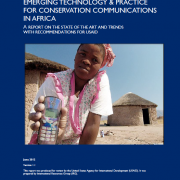Mobile Innovations for Climate Change Resilience!
One of the new approaches to the Climate Change menace being explored by most of the key stakeholders in the sector is the “Resilience” approach which focuses on enabling communities to better withstand, recover from, and adapt to the changing conditions posed by climate change.
This approach cannot be fully functional in this information age without the central role of information and communication technologies (ICTs) in general, and mobile technologies in specific. This is becoming obvious especially in the continent of Africa where the increase in terms of the number of mobile phone subscribers and penetration has been greatest. Recognizing this, the Global Humanitarian Forum together with Ericsson, the World Meteorological Organization, National Meteorological Services (NMSs), the Earth Institute at Columbia University, Zain and other mobile phone operators are aiming to deploy up to 5,000 automatic weather stations (AWSs) at wireless network sites across Africa within the next few years. This public-private-partnership aims to reinforce the capacities and the capabilities of national meteorological services with the goal of supporting local communities worst impacted by climate change through the improvement of weather monitoring.
In early 2009, the president of the Global Humanitarian Forum, Mr. Kofi Annan announced the Weather Information for All (WIFA) Initiative and as of the end of June, the WIFA Initiative have completed Phase I through installation of 19 AWSs in three East African countries – 1 in Kenya, 9 in Tanzania and 9 in Uganda. All 19 AWSs are fully operational and successfully transferring raw weather data to the National Meteorological Stations (NMSs). Automatic weather stations (AWS) are automated type of traditional weather stations that enable measurements from remote areas to save human labor. While AWS are known to deliver via local link to a computer system or via telecommunications or satellite systems, GSM mobile phone technology has also been used.
The clip below tells the Climate Change story and the efforts by the Global Humanitarian Forum to build the resilience for vulnerable communities:
The phase II of the Initiative is currently ongoing with the target of about 500 AWSs to be progressively installed throughout Kenya, Tanzania and Uganda, with the later addition of Burundi and Rwanda. A recent report by Uganda at the beginning of this year emphasized the utilization of mobile phone technology to develop a sustainable warning service that reduces the vulnerability of communities in the Lake Victoria Region to weather hazards. The report indicated that the quality of data being collected by the AWSs located at mobile phone mast sites is evaluated through a systematic and scientific (peer reviewed) data trial. This has led to the routine dissemination of more accurate, timely and reliable weather forecasts and warnings to the pilot communities of fishermen, in Uganda, for the duration of the trial. Seasonal and other weather information provided via Uganda Department of Meteorology website and disseminated via mobile WEB, or WAP, for the duration of the pilot for the chosen agricultural communities.
Approximately 70% of Africans rely on farming for their livelihood, and over 95% of Africa’s agriculture depends on natural rainfall – rain-fed agriculture. At the same time, rural farmers across the continent are known to utilize the strength of their local knowledge, skills, experiences, observation and insights to maintain or improve their livelihood in the absence of scientific resources. Unfortunately, the “Wicked Problem” of climate change is rendering some of these innovations and experiences unreliable. The dwindling weather and climate is preventing rural farmers from accurately predicting the weather and thereby thwarting them from making informed decisions, such as when to plant and harvest their crops.
In addition to this direct utilization of mobile technologies to gather weather information remotely and deliver up-to-date information to computer systems that are being used by rural communities, the ubiquitous use of mobile technologies could be see in a host of other subsidiary areas. A Reuters article pointed out at least ten ways by which ICTs and mobile technologies could help in climate change adaptation. Among these are:
i) The use of mobile phones, community radio and the Internet to enable information sharing, awareness raising and capacity building on key health threats, enabling effective prevention and response;
ii) ICT applications such as Geographic Information Systems (GIS) are being used to facilitate the monitoring and provision of relevant environmental information to relevant stakeholders, including decision-making processes for the adaptation of human habitats;
iii) Mobile phones and SMS are being used for reporting locally-relevant indicators (e.g. likelihood of floods) to greater accuracy and more precise flood warnings to communities;
iv) Access to insurance and information about national programs/assistance available to support vulnerable populations after floods, hurricanse, and others are being made possible through the Internet or the mobile phone;
v) ICTs are being used to enhance information about pest and disease control, planting dates, seed varieties, irrigation applications, and early warning systems, as well as improving market access, among others;
vi) Mobile phones can serve as tools to disseminate information on low-cost methods for desalination, using gray water and harvesting rainwater for every day uses, as well as for capacity building on new irrigation mechanisms, among others.
Mobile technologies are of no doubt capable of helping to prepare vulnerable communities to deal with stresses and disturbances as a result of climate change, while retaining the same basic structure and ways of functioning, hence an excellent tool for climate change resilience.






































